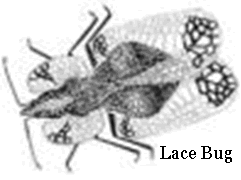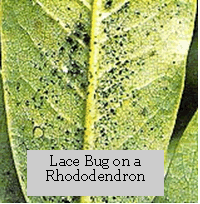Lace bugs are sucking insects named because of the flat lacelike wings of the adults. They are members of the Tingidea family and are pest insects. Do not confuse them with the beneficial lacewing insects which have long wings held vertically against their sides. The common lace bug species in Connecticut are the andromeda, azalea, elm, hawthorn, oak, rhododendron and sycamore lace bugs, each named for its principal host plant. The life cycles and control are all similar, except that the lace bugs that feed on deciduous plants (plants that shed their leaves in the fall) overwinter as adults underneath bark or in the leaf litter. The following description is of the andromeda lace bug, Stehanitis takeyai, the most common species encountered in this area.

The andromeda lace bug is believed to have been accidentally introduced into the United States from Japan in 1945. It is a serious pest of Japanese Andromeda, Pieris japonica.
Life Cycle
The andromeda lace bug overwinters as an egg on the undersides of the lower leaves of the plant. The eggs begin hatching in early to mid-May. The small (1/16-inch) black spiny nymphs (immature insects) begin to feed immediately. After one or two molts (growing stages), they scatter to other leaves. It takes about a month for the nymphs to become adults. The 3/16-inch adults have net-veined clear wings with black markings and a somewhat rectangular shape. Adults lay eggs along the midrib on the underside of the leaves. The andromeda lace bugs can have four or five generations a year in Connecticut.
Injury
Lace bugs feed by sucking juice from plant leaves, extracting the protein they need and excreting the excess juice as honeydew. The most common symptom of feeding is the stippled and mottled yellowish foliage. Positive signs of lace bugs are the insects, whitish cast-off skins, and/or dark brown tar-like excrement on the underside of the leaves. In heavy infestations, black sooty mold, a non-parasitic fungus, may develop on the honeydew. If leaves become covered with sooty mold, photosynthesis production is reduced, thereby reducing the production of carbohydrates needed by the plant. Damage is most severe on plants in full sun. Heavily damaged leaves become blanched and yellowish grey and may drop from the plant. This often results in some dieback of twigs and branches and a reduction in flowering the following spring.

Control
Spraying the young nymphs off the leaves with a strong jet of water from a garden hose in spring is a preferred, non-chemical control because the nymphs rarely make it back to the plant before they die. Horticultural oil or insecticidal soap are other organic controls for lace bugs. Lace bugs also have several natural predators that help minimize the population, and using these non-chemical controls, will ensure that those beneficial insects are not killed. To control lace bugs, thoroughly spray the undersides of the leaves as soon as nymphs appear in mid-May. Horticultural oil or insecticidal soap are organic controls for lace bugs. Thorough coverage of the undersides of the foliage is essential if good control is expected
Information on our site was developed for conditions in the Northeast. Use in other geographical areas may be inappropriate.
Despite good cultural practices, pests and diseases at times may appear. Chemical control should be used only after all other methods have failed.
For pesticide information or other questions please call toll free: 877-486-6271.
Revised by UConn Home and Garden Education Center 2016.
Issued in furtherance of Cooperative Extension work, Acts of May 8 and June 30, 1914, in cooperation with the U.S. Department of Agriculture, the Dean of the College, Cooperative Extension System, University of Connecticut, Storrs. The Connecticut Cooperative Extension System is an equal opportunity employer and program provider. To file a complaint of discrimination, write USDA, Director, Office of Civil Rights, Room 326-W, Whitten Building, Stop Code 9410, 1400 Independence Avenue, SW, Washington, DC 20250-9410 or call (202) 720-5964.